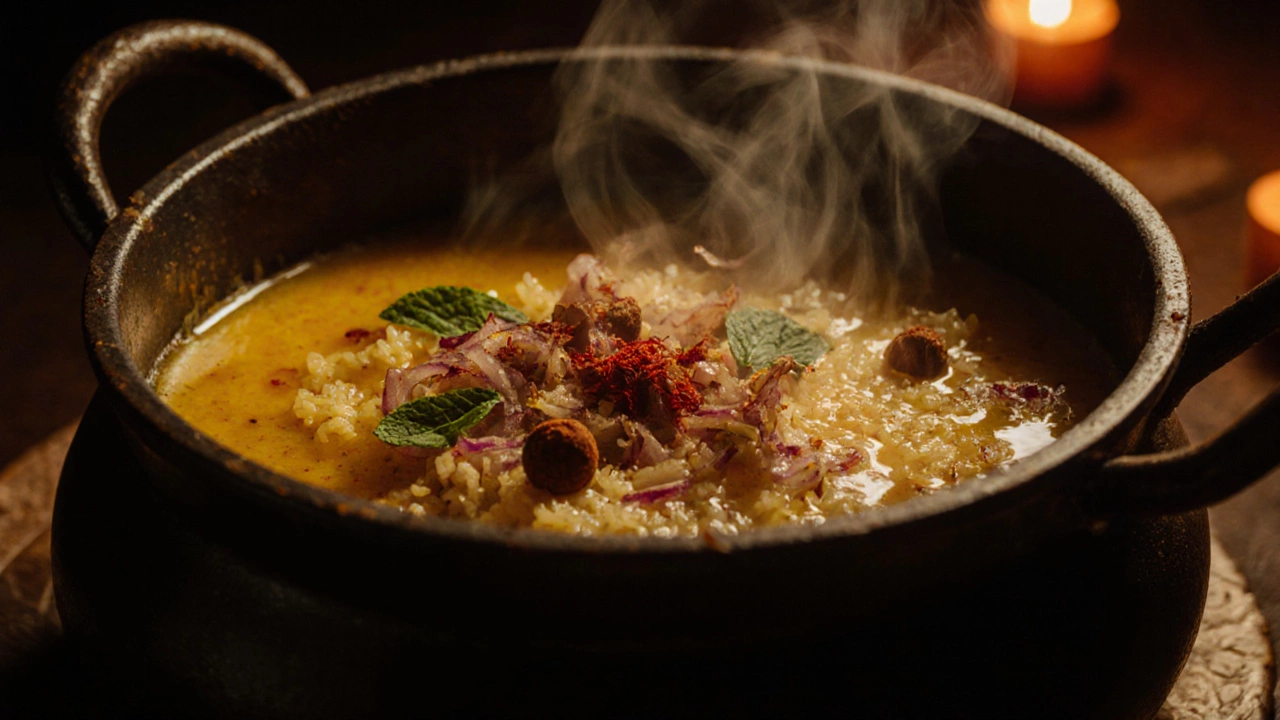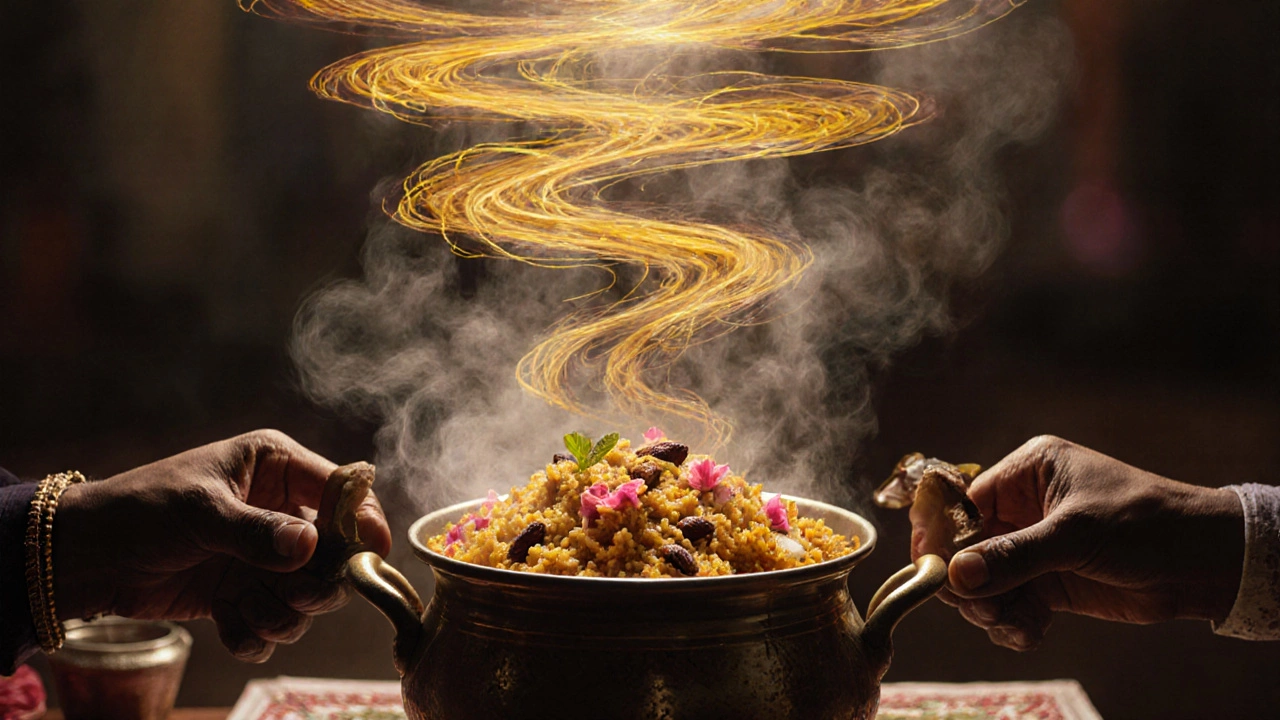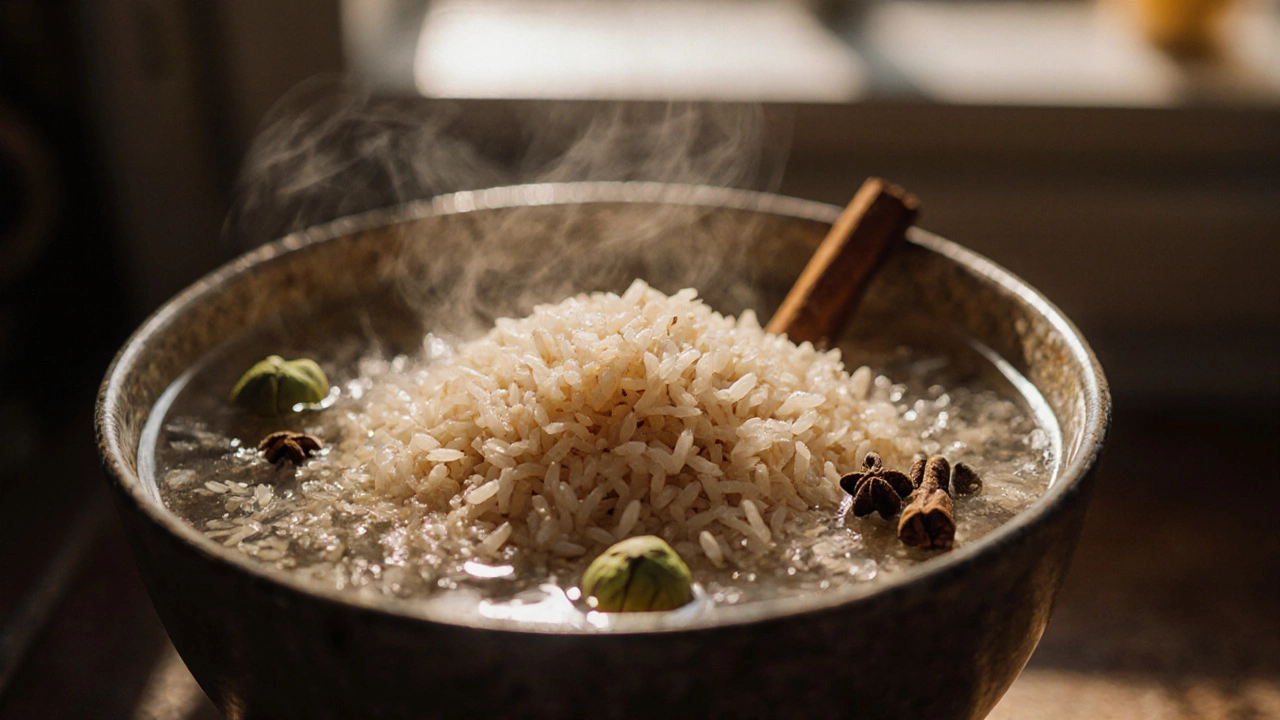28 Oct 2025
- 0 Comments
Ever opened a pot of biryani and been hit with that deep, warm, mouth-watering smell that makes your stomach growl before you even see the rice? That smell isn’t luck. It’s not just the meat or the rice. It’s the careful layering of spices, herbs, and techniques passed down through generations. If your biryani smells flat or one-note, you’re missing key pieces of the puzzle. Here’s what actually makes biryani smell incredible-and how to get it right every time.
The Foundation: Basmati Rice and Soaking
Good biryani starts with the rice. Not just any rice-Basmati. It’s longer, slimmer, and has a natural nutty fragrance that blooms when cooked. But soaking it matters more than you think. Soak the rice for 30 minutes in cold water before cooking. This isn’t just to soften it. It lets the grains absorb water evenly, so they don’t break during cooking. More importantly, it helps the rice hold onto the aroma of the spices you’ll add later. Dry rice acts like a sponge for water but ignores scent. Soaked rice? It holds onto fragrance like a towel holds heat.
The Aroma Powerhouse: Whole Spices
Ground spices give flavor, but whole spices give smell. The moment you heat oil or ghee and toss in whole spices, the kitchen transforms. Cumin seeds crackle. Cardamom pods pop open. Cloves release their sharp, sweet smoke. Bay leaves curl and soften, letting out their earthy perfume. These aren’t just garnishes-they’re the first layer of fragrance.
For biryani, you need at least these five:
- Green cardamom-sweet, floral, almost citrusy. Crush them lightly before adding to release oils.
- Cloves-pungent and warm. Use only 4-6 per pot. Too many and they overpower everything.
- Cinnamon stick-not powder. A 2-inch piece gives sweet woodiness without bitterness.
- Black cardamom-smoky, almost medicinal. This is what gives biryani its deep, lingering scent. Skip this, and your biryani feels incomplete.
- Bay leaves-they don’t taste strong, but they add a quiet, herbal backbone.
Toast them in hot oil for 30 seconds until fragrant. Don’t burn them. You want the scent to rise, not char.
The Secret Weapon: Saffron and Rose Water
Most people think saffron is just for color. It’s not. Real saffron threads-about 15-20 per pot-release a honeyed, earthy, almost hay-like fragrance when steeped in warm milk. Add this to the rice just before layering. That’s when the perfume hits your nose the strongest.
And then there’s rose water. Yes, really. A teaspoon stirred into the rice or drizzled over the layered biryani before sealing the pot. It’s subtle. You won’t taste it like perfume. But you’ll smell it-floral, clean, and unforgettable. It doesn’t make biryani smell like a garden. It makes it smell like a memory. This trick comes from old Hyderabadi kitchens. Skip it, and you lose that signature lift.

Onions: The Unsung Aroma Engine
Onions aren’t just for texture. Fried onions-crispy, golden, caramelized-are the secret to depth. You need two types: one fried until soft and sweet, the other fried until crisp and dark brown. The soft ones melt into the meat, adding body. The crispy ones sit on top, releasing a smoky-sweet scent as steam rises.
Use red onions. They’re sweeter and caramelize better. Fry them slowly in ghee or oil. Don’t rush. Let them turn deep amber. That’s where the magic happens. The smell of caramelized onions is one of the most comforting in Indian cooking. In biryani, it’s the bridge between meat and rice.
Herbs That Make the Difference
Coriander leaves? Everyone adds them. But fresh mint? That’s the real game-changer. Tear the leaves by hand, don’t chop. Chopping crushes the oils too early. Scatter them between layers. When the biryani steams, the mint releases a cool, bright note that cuts through the richness. It’s like a breeze in a warm room.
And don’t forget kewra water. It’s made from the flower of the pandanus tree. It’s not common in every kitchen, but if you’ve had a truly great biryani, you’ve smelled it. A few drops added to the rice or water gives a unique, slightly tropical, floral aroma. It’s not rose. It’s deeper. More mysterious. If you can’t find kewra water, skip it. Don’t substitute with extract. But if you can, use it. It’s the whisper that lingers after the main spices fade.
The Final Seal: Dum Cooking
Smell doesn’t just come from ingredients. It comes from how you cook. The dum method-sealing the pot with dough or a tight lid and cooking over low heat-is what traps all that fragrance inside. No steam escapes. The heat slowly pulls the aromas from the spices, meat, and rice into each grain. The rice doesn’t just absorb flavor-it absorbs scent.
Use a heavy-bottomed pot. Cast iron or thick aluminum works best. Seal the lid with flour and water paste. Let it cook for 20-30 minutes on very low heat. Don’t peek. Every time you lift the lid, you lose half the aroma. The longer you seal it, the more the scent melds. That’s why slow-cooked biryani smells like it’s been waiting for you.

What Ruins the Smell
Even if you use all the right spices, one mistake kills the aroma:
- Overcooking the spices-burnt cumin or cardamom tastes bitter and smells like smoke, not spice.
- Using old or stale spices-if your cardamom pods don’t crackle when you bite them, they’re dead. Replace them yearly.
- Adding ground spices too early-they lose their punch. Add them after the whole spices have bloomed.
- Skipping the saffron soak-adding dry saffron to rice? It won’t release scent. Always steep in warm milk first.
- Opening the pot too soon-you’re letting the perfume escape before it has time to settle.
Quick Fix for Weak Smell
Forgot to soak the rice? Didn’t fry the onions enough? The biryani smells okay, but not amazing? Here’s a last-minute trick:
Heat a small spoon of ghee in a pan. Add 2 crushed green cardamoms, 2 cloves, and a tiny pinch of saffron soaked in 1 tbsp milk. Let it sizzle for 10 seconds. Pour this hot oil over the top of the cooked biryani. Cover immediately and let it sit for 5 minutes. The steam will carry the fresh aroma down into the rice. It won’t replace the real thing-but it’ll save dinner.
Why This Matters Beyond Taste
The smell of biryani isn’t just about food. It’s about hospitality. In India, the scent of biryani cooking means someone’s working hard to make you feel welcome. It’s the smell of celebration, of family gatherings, of Friday nights and Eid mornings. Getting the aroma right isn’t a cooking tip-it’s a cultural detail. It’s the difference between a meal and a moment.
So next time you make biryani, don’t just taste it. Breathe it in. Let the spices tell their story. Because the best biryani isn’t just eaten-it’s remembered by its smell.
Can I use regular rice instead of Basmati for biryani?
No, regular rice won’t give you the same smell or texture. Basmati has a natural fragrance and long grains that stay separate when cooked. Other rice types become sticky and lack the floral, nutty aroma that defines biryani. If you can’t find Basmati, look for aged Basmati-it’s even better.
Why does my biryani smell like plain rice?
You likely skipped the whole spice blooming step or didn’t fry the onions properly. Whole spices need to be toasted in oil first to release their oils. If you added them directly to the rice or cooked them too long, they lost their scent. Also, if you didn’t soak the rice, it didn’t absorb the aromas. Always bloom spices, fry onions until golden, and soak rice for 30 minutes.
Is kewra water the same as rose water?
No. Rose water comes from roses and has a sweet, floral scent. Kewra water comes from the pandanus flower and has a deeper, more exotic, slightly fruity aroma. Both are used in biryani, but they’re not interchangeable. Rose water is more common in home kitchens. Kewra is used in restaurants and traditional Hyderabadi biryanis for that signature lift.
How much saffron should I use for one pot of biryani?
Use 15-20 threads per pot. That’s about 0.1 to 0.2 grams. Too little and you won’t smell it. Too much and it tastes medicinal. Always soak the threads in 2 tablespoons of warm milk for 15 minutes before adding. The milk helps release the aroma evenly into the rice.
Can I make biryani smell good without using meat?
Absolutely. Vegetable biryani can smell just as rich. Use the same spices, soak the rice, fry onions until crisp, and add saffron and rose water. For depth, add a pinch of asafoetida (hing) when blooming spices-it mimics the umami of meat. The key isn’t the protein. It’s the layering of scent.
